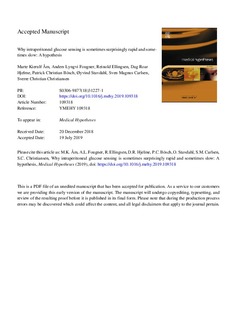| dc.contributor.author | Åm, Marte Kierulf | |
| dc.contributor.author | Fougner, Anders Lyngvi | |
| dc.contributor.author | Ellingsen, Reinold | |
| dc.contributor.author | Hjelme, Dag Roar | |
| dc.contributor.author | Bösch, Patrick Christian | |
| dc.contributor.author | Stavdahl, Øyvind | |
| dc.contributor.author | Carlsen, Sven Magnus | |
| dc.contributor.author | Christiansen, Sverre | |
| dc.date.accessioned | 2019-09-04T06:49:43Z | |
| dc.date.available | 2019-09-04T06:49:43Z | |
| dc.date.created | 2019-07-30T09:27:56Z | |
| dc.date.issued | 2019 | |
| dc.identifier.citation | Medical Hypotheses. 2019, 132 (109318) | nb_NO |
| dc.identifier.issn | 0306-9877 | |
| dc.identifier.uri | http://hdl.handle.net/11250/2612345 | |
| dc.description.abstract | The artificial pancreas requires fast and reliable glucose measurements. The peritoneal space has shown promising results, and in one of our studies we detected glucose changes in the peritoneal space already at the same time as in the femoral artery. The peritoneal lining is highly vascularised, covered by a single layer of mesothelial cells and therefore easily accessible for proper sensor technology, e.g. optical technology. We hypothesize that the rapid intraperitoneal glucose dynamics observed in our study was possible because the sensors were located directly at the peritoneal lining, at the point where the glucose molecules entered the peritoneal space. Glucose travels slowly in fluids by diffusion, and a longer distance between the sensor and the peritoneal lining would consequently result in slower dynamics. We therefore propose to place the glucose sensor in an artificial pancreas as closely to the peritoneal lining as possible, or even utilize appropriate sensor technology to measure glucose in the peritoneal lining itself. | nb_NO |
| dc.language.iso | eng | nb_NO |
| dc.publisher | Elsevier | nb_NO |
| dc.rights | Attribution-NonCommercial-NoDerivatives 4.0 Internasjonal | * |
| dc.rights.uri | http://creativecommons.org/licenses/by-nc-nd/4.0/deed.no | * |
| dc.subject | Type 1 diabetes | nb_NO |
| dc.subject | Kontinuerlig glukosemåling | nb_NO |
| dc.subject | Continuous glucose measurement | nb_NO |
| dc.subject | Glukosemåling | nb_NO |
| dc.subject | Glucose sensing | nb_NO |
| dc.subject | Peritoneum | nb_NO |
| dc.title | Why intraperitoneal glucose sensing is sometimes surprisingly rapid and sometimes slow: A hypothesis | nb_NO |
| dc.type | Journal article | nb_NO |
| dc.type | Peer reviewed | nb_NO |
| dc.description.version | acceptedVersion | nb_NO |
| dc.subject.nsi | VDP::Medisinsk teknologi: 620 | nb_NO |
| dc.subject.nsi | VDP::Medical technology: 620 | nb_NO |
| dc.source.volume | 132 | nb_NO |
| dc.source.journal | Medical Hypotheses | nb_NO |
| dc.identifier.doi | 10.1016/j.mehy.2019.109318 | |
| dc.identifier.cristin | 1713136 | |
| dc.relation.project | Norges forskningsråd: 248872 | nb_NO |
| dc.description.localcode | © 2019. This is the authors’ accepted and refereed manuscript to the article. Locked until 20 July 2020 due to copyright restrictions. This manuscript version is made available under the CC-BY-NC-ND 4.0 license http://creativecommons.org/licenses/by-nc-nd/4.0/ | nb_NO |
| cristin.unitcode | 1920,15,0,0 | |
| cristin.unitcode | 194,65,15,0 | |
| cristin.unitcode | 194,63,25,0 | |
| cristin.unitcode | 194,63,35,0 | |
| cristin.unitname | Medisinsk klinikk | |
| cristin.unitname | Institutt for klinisk og molekylær medisin | |
| cristin.unitname | Institutt for teknisk kybernetikk | |
| cristin.unitname | Institutt for elektroniske systemer | |
| cristin.ispublished | false | |
| cristin.fulltext | preprint | |
| cristin.fulltext | postprint | |
| cristin.fulltext | original | |
| cristin.qualitycode | 1 | |

